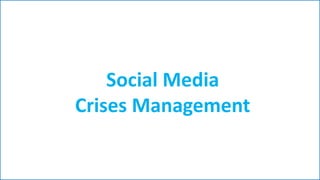Best Online Crises Management Practice
- 2. Index ŌĆó ŌĆó ŌĆó ŌĆó ŌĆó ŌĆó ŌĆó Introduction Components of social listening Causes of social media crises Response & Crises Management Escalation Metrics Multi-channel best practices Golden Rules of Crisis Management
- 3. Introduction ŌĆó ŌĆó ŌĆó ŌĆó Social media is all about driving conversations People talk about brands in majorly two situations; When they are happy When they are unhappy On social media, it is a norm to be a critic and scrutinize the brand publicly to gain attention from varied types of spectators We will highlight globally adapted ŌĆśEdelman Digital- Best Practice for Crises & Response ManagementŌĆÖ
- 4. Components of social listening Monitor Determine and respond proactively objectives for social listening Develop Select a response and crisis strategy tools to facilitate monitoring
- 5. Causes of social media crises
- 6. Channels of crises Online conversations about organizations, brands, products and services can occur on three types channels. Owned Outreach Earned ŌĆó Includes the organization or brandŌĆÖs presence on Facebook, Twitter, Blogs etc ŌĆó Includes coverage that has been sponsored, seeded, or incentivized on external social properties, blogs, etc ŌĆó Includes non solicited online mentions on external social properties, blogs, forums etc
- 7. Escalation metrics STATUS ESCALATION BENCHMARK Level 1 LEVEL 2 LEVEL 3 LEVEL 4 Number of people talking about this <5 >5 ŌĆō 20 >20 ŌĆō 50 >50 Total number of followers of influencers/sources talking about the issue <20 >20 ŌĆō 50 >50 ŌĆō 100 >100 <6hrs <2hrs RESPONSE TIME BASED ON CHANNELS Facebook <24hrs Twitter <8hrs RESPONSE PROTOCOL Alert the JLR team Evaluate based on content, influence and volume Track & Record the conversation ACTION Respond/Not Respond Evaluate based on accuracy, source, timeframe (re-occurring versus new) Respond after fact check Identify & Reach the influencers with a solution Address problem solved, publicly
- 8. Multi-channel best practices Illegal or Offensive Content It is acceptable to report and remove (where possible) any content that is illegal or offensive towards any entity. Text, images, videos and links which depict any of the following should be removed and the user reported to the networking site's administration. ŌĆō ŌĆō ŌĆō ŌĆō ŌĆō ŌĆō ŌĆō ŌĆō ŌĆō Images or messages that threaten individuals, multiple individuals or minority groups Any abusive content including profanity and remarks which are sexist, religious, or homophobic If someone looks as though they are campaigning on behalf of a political party or group Blasphemous and/or religious imagery and/or any image or discussion deemed to incite religious hatred Any racist material of any form ŌĆō images, videos, messages that contains any racist terms or hints of racism. Content featuring weapons should be removed, unless they are being used for valid legal reasons such as sporting events Any content featuring humans and/or animals in distress and violent situations Vandalism, fraudulent or criminal acts such as underage drinking, taking of drugs, irresponsible driving, arson, and terrorism Copycat material ŌĆō any content that may persuade viewers to commit illegal acts or acts that could cause harm if copied
- 9. Multi-channel best practices Be Truthful If you have made a mistake, issue a clarification or a withdrawal or whatever may suit the circumstance and make it abundantly clear that you have done so. Social media is a relatively tolerant neighborhood, mistakes and errors will not make you a social outcast if you take responsibility. Rather than editing your content once it has been published, find ways to make your corrections transparent. Educate Employees All policy guidelines and crisis planning will be meaningless if educating employees is not made a priority. Along with employees, any partner agencies should be made aware of policies, procedures and expectations. DonŌĆÖt Pick Fights When you come across misrepresentations or blatantly false statements about Tata by bloggers, the media, or anyone else, you should address these misrepresentations even if it entails joining someone else's conversation. However, emphasize facts and ensure the same are publicly available, and do not argue.
- 10. Golden rules of crises management ŌĆó ŌĆó ŌĆó ŌĆó ŌĆó ŌĆó Plan for every scenario. A list of expected FAQŌĆÖs help Monitor your brand /corporate mentions 24 x 7 x 365 Build your network before you need it Be human, Be transparent, Be quick Empower your employees, train them to be social Be active on social, itŌĆÖs an experiential medium
Editor's Notes
- SM Code of Conduct- Abusive, Fake, Disrespectful, Controversial
- Vandalism- Destruction of otherŌĆÖs property











